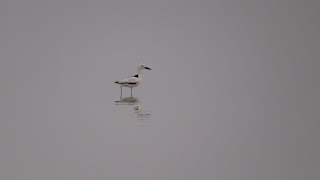The crab plover is remarkable for being the only representative of the Dromadidae family, which means that in evolutionary terms this unusual shorebird has no close living relatives This species has a distinctive appearance, with white plumage on the body and head, contrasting with jet-black primaries and back feathers, and a long, black, gull-like bill. Like most waders, the legs are long with partially webbed toes, and the tail is short. Juvenile crab plovers lack the bright white adult plumage, appearing uniform grey-brown instead

The crab plover inhabits sandy and muddy shores on mainland coasts and on islands, as well as intertidal sandflats and mudflats, estuaries, lagoons, and exposed coral reefs During breeding, this species has a specific requirement for sandy islands or extensive dunes in which nesting burrows can be excavated
Numbers are highest from September to April when over 1,000
can be present in Kenya around Mida Creek Watamu Malindi, Mida Creek is a tidal inlet that expands across an area of 32 km2. It comprises
different types of habitats that are influenced by the tide, for example, mud
and sand flats, open shallow waters and mangrove forests
The mud/sand flats are feeding and resting grounds for large populations of around 65 species of aquatic birds; some residents, others local or seasonal distant migrants. Mida Creek is an important passage and wintering area for Palaearctic migrant waders. Counts of over 6,000 waders have been made on Mida Creek including seven species that are regionally threatened. The mangroves around the edge of the creek are also important roosting places. Different species of Waders
The populations of Greater and Lesser Sandplover and Crab-plovers at Mida Creek are internationally important. The creek is a significant feeding area for Dimorphic Egrets, Lesser Crested and Roseate Terns. Common migrant shorebirds here include Sanderling, Curlew Sandpiper, Little Stint, Whimbrel, Grey Plover, and Greater and Lesser Sandplover. In the landward area around the creek, a further 115 species have been recorded.
Mida Creek is a recognized International Bird Area and together with Arabuko-Sokoke Forest forms a UNESCO Biosphere Reserve. It is not only a paradise for national waterfowls but also migrating birds from Europe and Eurasia to find a place to rest during their journey or they choose to stay at Mida Creek to over-winter.








